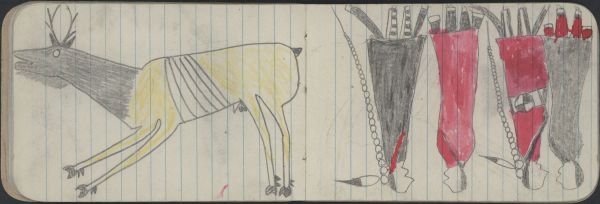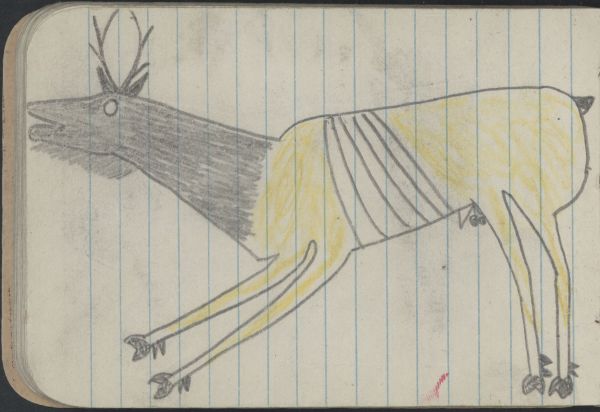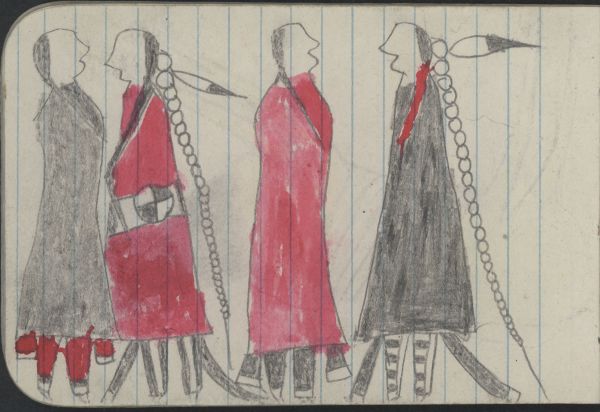ANIMALS, ELK: Bull; COURTING, TWO COUPLES: 2 Men in Black , Red Blankets Face Women in Red , Black Blankets
Ethnographic Notes
34 ANIMALS, ELK. A bull elk runs from right to left across the page (extended legs show motion). He has dark shoulders and yellow body. He has a small rack of antlers (three by three points), and his round eye is created by an outlined circle of unpigmented paper, contrasting with the dark hide around it. Penciled details include antlers, ears, beard, split hooves, dewclaws, genitalia, ribs, and tail. His midsection is striated, perhaps indicating ribs. In other ledgers, elk do not have such detailed ribs (Petersen, 1983: 277; Keeling Ledger, PILA plate 5, Nebraska State Historical Society 11310-55). The alteration of an animal can indicate intention, especially seen in name glyphs. For example, the name glyph for Lean Bear is a bear with a constricted midsection (Cheyenne Dog Soldiers: A Ledgerbook History of Coups and Combat, Afton et al., 1997: 323). Composition of the drawing resembles the same right-to-left, full-page orientation of human warrior portraits. Twelve nearly identical images of this male elk appear in this ledger (plates 19-23; 30, 32, 37-41). In the Northern Cheyenne-Kansas State Historical Society ledger, several meanings can coexist for this unusual depiction of an elk. This is consistent with the accretive character of ledger art; Candace Greene asserts about ledger drawings: "Every figure fills a number of categories simultaneously" (1996: 26). In this ledger, the elk with ribs showing can be simply an undernourished elk. Late winter and early spring are seasons when elk have depleted fat reserves, and the Northern Cheyenne survivors of the Fort Robinson Breakout were in the Dodge City jail from February through June of 1879. It represents a male. Another layer of meaning could be a man�s name. One of the Northern Cheyenne men who fled Indian Territory in September, 1878, was named Starving Elk. He followed Little Wolf, who led a one group to the Sand Hills country of Nebraska, where they wintered without incident until their surrender in March, 1879 (Powell, Sweet Medicine, 1969: 210-1). Two other men were known as Starving Elk, according to Powell (personal correspondence to Powers, 2010), but only one individual was part of the Cheyenne group who fled Darlington Agency in Oklahoma (Indian Territory). Another association with elk would be the Elk Society, one of the warrior societies among the Northern Cheyenne, along with Crazy Dog and Fox, according to Wooden Leg (Thomas Marquis, Wooden Leg: A Warrior Who Fought with Custer, 1931: 56). E. Adamson Hoebel and Tom Weist list more warrior societies; these are Elk (Hoof Rattle, Elk Scraper, or Crooked Lance), Fox (Swift Fox or Kit Fox), Northern Crazy Dogs, Shield (Red Shield or Buffalo Bull Tail), Dog (Dog Men or Dog Soldiers), and Bowstring (later Owl Friend�s Bowstring or Wolf) (Hoebel, 1960: 40; Weist, 1977: 38). James N. Leiker and Ramon Powers list these societies: �Fox, Elk, Shield, Bowstring Soldiers, Dog Men, and Northern Crazy Dogs� (The Northern Cheyenne Exodus in History and Memory, 2011: 28-9). Finally, elk have spiritual associations, as they can represent Maiyun, Above Powers, along with buffalo, bear, wolf, and swifthawk (Powell, 1969: 437-9). So a spiritual being of the sky realm may take form as an elk. 35 Two couples face each other, dressed in courtship finery. The first and third men, facing to the left and in the dominant right-to-left position, wear German silver hairplate ornaments that trail to the ground, with an immature golden eagle feather attached between the first and second hairplates. The first man�s one visible braid is wrapped in red trade cloth. He wears a black robe, black breechclout (with white edging) and beaded black-and-white �box� design leggings, a pattern often seen in warrior regalia (Cowdrey, 1999: 210; Lanford, 2003: 162-4). The woman facing him wears a solid red blanket. She has a black braid down her visible shoulder. Her plain black leggings and dress tabs or panels are the same dark trade cloth with undyed selvedge edges. The third figure, a man facing left, is wrapped in a red blanket with medicine wheel beaded strip at waist level. His one visible braid is unwrapped. He has black breechclout and black leggings with one white vertical stripe down the legs. The last woman wears a solid black robe. Her leggings and dress panel ends that show below the blanket are red with white selvedge edging. The cuffs of her leggings are black, white, and black horizontal bands. This is the first of a sequence of several drawings with similar composition (plates 19, 21-25). See plate 1 for further discussion of courtship conventions. Media: Pencil outlines, details and fill; red watercolor


